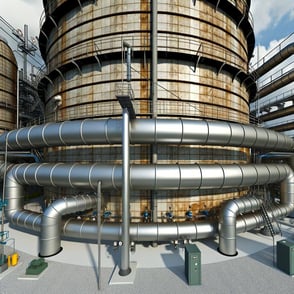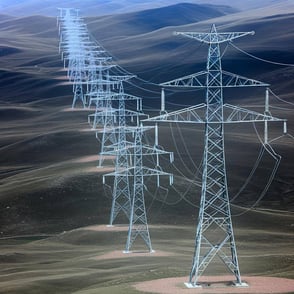Oil-Fired Energy Generation
Oil-fired energy generation produces electricity by burning oil. While it offers flexibility and reliability, it faces challenges from environmental concerns and rising renewable energy sources.
What is Oil-Fired Energy Generation?
Oil-fired energy generation utilizes oil to produce electricity. This method, while less common today due to the rise of natural gas and renewable energy sources, remains a significant part of the global energy mix in certain regions. Oil-fired power plants, also known as oil-burning power stations or oil-fired generating stations, are facilities that burn oil to generate electricity. These plants play a vital role in providing backup power and meeting peak electricity demand, especially in areas where other energy sources are not readily available.
Historically, oil-fired power plants were widely used in the mid-20th century, particularly in regions with abundant oil supplies. These plants can burn different types of oil, including heavy fuel oil (used in large power plants due to its cost-effectiveness), diesel (used in smaller plants and for emergency backup generators), and residual oil (a byproduct of refining crude oil, used in some older power plants), offering adaptability in various geopolitical and economic contexts. Oil-fired plants are reliable and capable of producing large amounts of electricity from relatively small quantities of fuel.
How Oil-Fired Energy Generation Works
Oil-fired power plants generate electricity by burning oil in a combustion process. There are two main types of oil-fired power plants: steam turbine plants and internal combustion engine plants.
In steam turbine oil-fired power plants, oil is burned in a boiler to produce high-pressure steam. The steam is directed to a steam turbine, causing it to spin. The turbine is connected to a generator, which converts the mechanical energy into electrical energy. The steam is then condensed back into water in a condenser and returned to the boiler to be heated again, completing the cycle. These plants are capable of generating large amounts of electricity and are typically used for base load or continuous power generation.
Internal combustion engine oil-fired power plants, as the name would suggest, use internal combustion engines. These engines are similar to those found in large ships or diesel locomotives. Oil is injected into the engine’s cylinders, where it is ignited and burned. The combustion process drives the pistons, which are connected to a crankshaft that turns a generator, producing electricity. Internal combustion engine plants are often used for smaller-scale power generation and can be quickly started and stopped, making them suitable for backup power and peak load applications.
.png?width=860&height=393&name=Combustion_turbine_diagram%20(1).png)
The use of advanced technologies, such as high-efficiency boilers and emissions control systems, can improve the performance and environmental impact of these plants.
The Impact of Oil-Fired Energy on the Energy Sector
Oil-fired energy generation has historically played a significant role in the energy sector, providing a reliable source of electricity. Oil-fired power plants offer flexibility and reliability, as they can be quickly ramped up to meet sudden increases in electricity demand and are often used as backup power sources during emergencies or peak load periods. This ability to provide on-demand power is crucial for maintaining grid stability and ensuring a continuous electricity supply. Additionally, oil-fired plants can be located in remote areas where other energy sources are not feasible, supporting regional energy security. Economically, oil-fired energy contributes to the diversification of the energy mix, reducing reliance on a single energy source. The infrastructure for oil storage and transportation is well-established, providing a secure supply chain for power generation.
However, burning oil for electricity production releases greenhouse gases and pollutants, contributing to air pollution and climate change. The environmental impact of oil-fired power plants is a significant concern, prompting efforts to develop cleaner and more sustainable energy alternatives. Natural gas plants, which are more efficient and produce fewer emissions, have become a preferred choice for new power generation capacity. Renewable energy sources such as wind and solar are also gaining traction due to their environmental benefits and decreasing costs. Consequently, many countries are phasing out oil-fired power plants in favor of these cleaner energy alternatives. Additionally, the cost of oil can be volatile, leading to fluctuating electricity prices and economic uncertainty.
Conclusion
Oil-fired energy generation remains part of the global energy mix, providing reliable and flexible electricity supply. While its role has diminished with the rise of natural gas and renewable energy sources, oil-fired power plants continue to play a crucial role in meeting peak demand and ensuring grid stability. By burning oil, these plants offer on-demand power generation, supporting energy security and economic activity. As technology advances and environmental regulations evolve, the focus on reducing emissions and improving efficiency will be key to the future of oil-fired energy generation.
Glossary
- Oil-Fired Energy Generation: The process of producing electricity by burning oil in power plants.
- Oil-Burning Power Station: A facility that generates electricity by burning oil, also known as an oil-fired generating station.
- Steam Turbine Oil-Fired Power Plant: A type of oil-fired power plant that uses oil to produce steam, which drives a steam turbine connected to a generator.
- Internal Combustion Engine Oil-Fired Power Plant: A type of oil-fired power plant that uses internal combustion engines to generate electricity.
- Boiler: A device that burns oil to produce high-pressure steam for electricity generation.
- Steam Turbine: A device that converts high-pressure steam into mechanical energy to drive a generator.
- Condenser: A component that cools and condenses steam back into water for reuse in the boiler.
- Internal Combustion Engine: An engine that burns oil to drive pistons connected to a crankshaft, generating electricity.
- Transformer: A device that increases or decreases the voltage of electricity for efficient transmission and distribution.
- Greenhouse Gas Emissions: Gases released into the atmosphere that contribute to the greenhouse effect and global warming, such as carbon dioxide and methane.
- Emissions Control Systems: Technologies, such as scrubbers and catalytic converters, that reduce pollutants emitted from power plants.
- Peak Load: Periods of high electricity demand when additional power generation capacity is needed.
.png?width=200&height=80&name=etpa-logo-color%20(1).png)































.png)
.png)
-1.png?width=250&height=100&name=etpa-logo-color%20(1)-1.png)